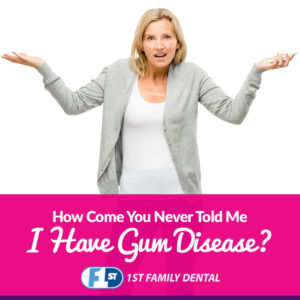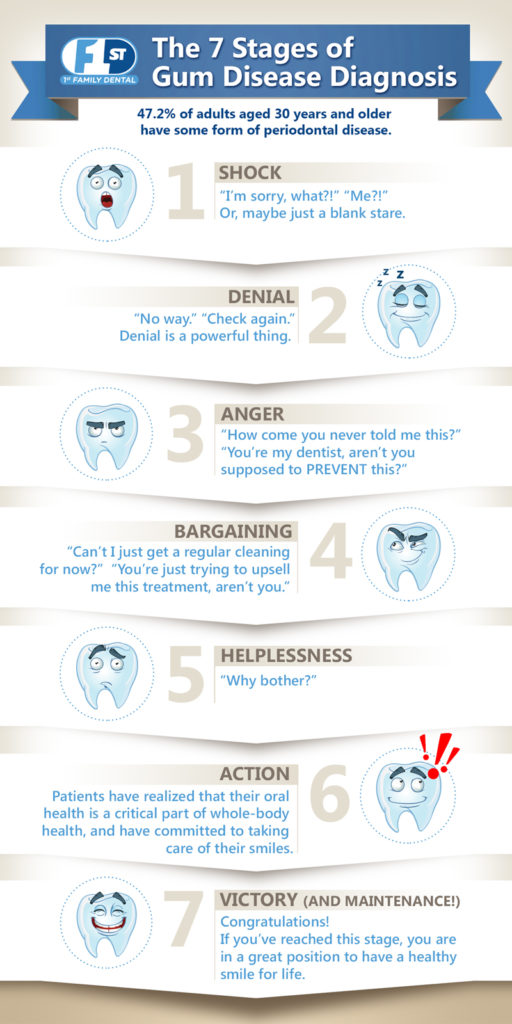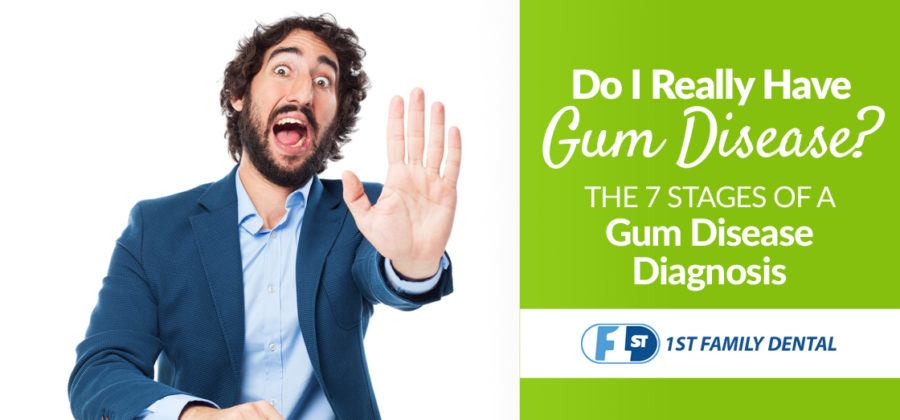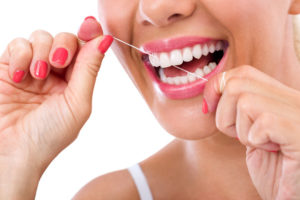“How often do you floss?” We know this question annoys a lot of our patients. Maybe even you. That’s because it’s typically accompanied by your dentist or hygienist probing your gum line, which can sometimes be a little bit painful. Even though we have assured you in a past blog that we only poke at your gums because we care about you, many people still haven’t gotten the message about how important it is to floss, which typically leads to the question; “Do I really have gum disease?”
In fact, a recent study from the Center for Disease Control that was just released reported that nearly 40% of people admitted that they don’t floss their teeth every day, and a whopping 32% reported that they don’t floss their teeth at all.
We’re sorry to report that the results of this study do not surprise us. It makes a lot of sense that nearly half of American adults age 30 and up have some form of gum disease.
Do I Really Have Gum Disease? The 7 Stages of a Gum Disease Diagnosis
What happens in our heads when we hear that dreaded gum disease diagnosis? Do I really have gum disease?! Based on our interactions with our patients, we’ve come up with the 7 stages of gum disease diagnosis.
Stage 1: SHOCK
“I’m sorry, what?!” “Me?!” Or, maybe just a blank stare.
We know it’s hard to concentrate and focus during a diagnosis discussion. We also know for some folks it’s just hard to get yourself into the office for a checkup. Many people are genuinely shocked at a gum disease diagnosis. Healthy gums are firm and pink, and don’t bleed when you floss them. You can learn more about what gum disease is, and how it’s diagnosed here. Gum disease can be located in one specific area, or can affect the whole mouth. Maybe you expected to hear you have a cavity or two, but gum disease?!
Stage 2: DENIAL
 “No way.” “Check again.” Denial is a powerful thing.
“No way.” “Check again.” Denial is a powerful thing.
The human brain can do amazing things to protect itself from things we may not want to have to deal with. Our resident blogger, Jessica, was in total denial of her own gum disease diagnosis. She’d never had a cavity before and there was no WAY she had gum disease. She was also deep in denial about her “perfect” flossing habits. Gum disease is diagnosed through dental x-rays, visual exams, and measuring “pocket” depth, or the space between your gums and teeth/jaw. Gingivitis, the milder form of gum disease, is curable and preventable just by improving your home oral hygiene routine. Periodontitis is the more advanced form of gum disease, which requires more involved treatment, and left untreated, can lead to tooth loss.
Stage 3: ANGER
“How come you never told me this?” “You’re my dentist, aren’t you supposed to PREVENT this?”
Anger is unfortunately a fairly common emotion we see when diagnosing and speaking with patients about their condition. Gum disease can be caused by or made worse by conditions such as diabetes, pregnancy hormones, chemotherapy drugs, and other prescriptions that cause dry mouth. It can also be genetic – despite our greatest efforts.
However, gum disease is most commonly the result of not flossing enough, properly, or at all. And chances are we’ve been telling you about the importance of flossing your teeth. We walk a fine line when it comes to oral hygiene education. We want you to have a great oral hygiene routine at home. We try to provide oral hygiene education in a way that each person can really hear. Sometimes we can get through, and sometimes we just can’t. If you’re angry, it’s OK. If you want a second opinion – that’s OK, too. In fact, we encourage it. We can talk about it. Just don’t give up yet.
Stage 4: BARGAINING
“Can’t I just get a regular cleaning for now?” “You’re just trying to upsell me this treatment, aren’t you.”
The short answer to those questions is “no.” If you’ve been diagnosed with periodontitis, we can’t ignore it and provide you with treatment that could make it worse or potentially harm you in any other way. This may be frustrating, but our job is to help you have your healthiest smile, and to tell you the truth. Scaling and root planing (SRP), commonly referred to as a “deep dental cleaning” is not an upsell. It’s a treatment for a diagnosable condition. We are happy to show you your x-rays, and demonstrate how we came to our diagnosis. We always encourage our patients to get a second opinion if they want one. Unfortunately, however, there is no bargaining when it comes to gum disease. Periodontitis is a condition of inflammation and infection, and that must be treated first.
Stage 5: HELPLESSNESS
“Why bother?”
This is the difficult stage where patients finally realize the inevitable, and can often feel discouraged. Some patients are frustrated that they may need to postpone teeth whitening or an implant for a while until their gum disease has been addressed. If you’ve reached this stage, please don’t give up! Gum disease is treatable and curable. Many dental insurance policies do cover gum disease treatment. You CAN whip your home oral hygiene routine into shape. Our dentists and hygienists can help you with tips and techniques – you need only supply the commitment. You can do it!
Stage 6: ACTION
Patients have realized that their oral health is a critical part of whole-body health, and have committed to taking care of their smiles.
The most common treatment for periodontitis is scaling and root planing. This can be done over one or more visits, depending on the location and diagnosis. You can read up on how the treatment works here. After gum disease treatment, there is usually a follow up visit a week or two after treatment to confirm you’re healing up well, and that your home oral hygiene routine is on point. After that, you’ll come in for “maintenance” visits, which can be every 2 or 3 months for a little while. This is to make sure your gum disease has been duly vanquished.
Step 7: VICTORY (AND MAINTENANCE!)
 Congratulations! If you’ve reached this stage, you are in a great position to have a healthy smile for life.
Congratulations! If you’ve reached this stage, you are in a great position to have a healthy smile for life.
Once periodontitis has been successfully treated, your dentist will usually tell you it’s time to go back to your regular checkup and cleaning routine, and to keep up a great self-care regimen at home which includes brushing and flossing every single day. We’ve had so many patients tell us that they had been feeling generally unwell, and almost immediately after they treated their gum disease, they felt great again! Gum disease may not be something that we talk to each other about, but if 47% of adults over the age of 30 are living with it, maybe now is the time to start encouraging each other to take good care of our smiles.
The ” Do I Really Have Gum Disease” Infographic

Have you recently been diagnosed with gum disease and wondering “do I really have gum disease”? Share your thoughts and experiences in our comments section below.
Leave a comment





4 Comments
Leave your reply.